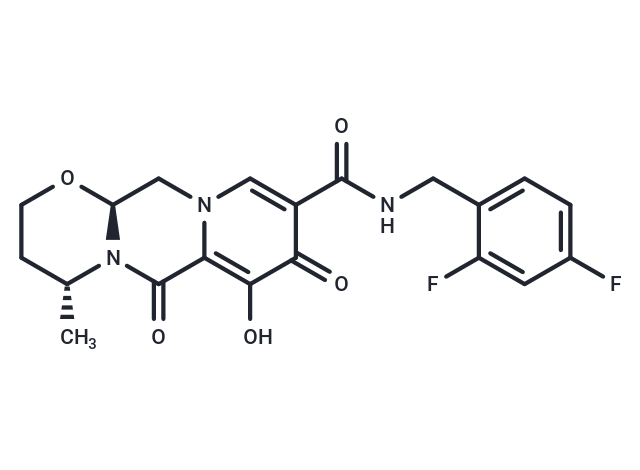Shopping Cart
Remove All Your shopping cart is currently empty
Your shopping cart is currently empty
Dolutegravir (GSK1349572) (IC50=2.7 nM), a two-metal-binding HIV integrase inhibitor, exhibits medium activity against raltegravir-resistant signature mutants Y143R, Q148K, N155H, and G140S/Q148H.

| Pack Size | Price | USA Warehouse | Global Warehouse | Quantity |
|---|---|---|---|---|
| 1 mg | $30 | In Stock | In Stock | |
| 5 mg | $68 | In Stock | In Stock | |
| 10 mg | $113 | In Stock | In Stock | |
| 25 mg | $180 | In Stock | In Stock | |
| 50 mg | $247 | In Stock | In Stock | |
| 100 mg | $328 | In Stock | In Stock | |
| 200 mg | $479 | In Stock | In Stock | |
| 1 mL x 10 mM (in DMSO) | $63 | In Stock | In Stock |
| Description | Dolutegravir (GSK1349572) (IC50=2.7 nM), a two-metal-binding HIV integrase inhibitor, exhibits medium activity against raltegravir-resistant signature mutants Y143R, Q148K, N155H, and G140S/Q148H. |
| Targets&IC50 | HIV integrase:2.7 nM |
| In vitro | S/GSK1349572 shows the potent inhibitory effect on nine clinical isolates from integrase inhibitor-naive HIV-2-infected patients with EC50 ranging from 0.2 nM -1.4 nM. [1] In vitro, S/GSK1349572 inhibits recombinant HIV-1 integrase-catalyzed strand transfer with IC50 of 2.7 nM. Furthermore, S/GSK1349572 potently inhibits HIV replication in cells such as peripheral blood mononuclear cells (PBMCs), MT-4 cells and CIP4 cells infected with a self-inactivating PHIV lentiviral vector with EC50 of 0,51 nM, 0.71 nM and 2.2 nM, respectively. [2] In vitro, S/GSK1349572 exhibits potent activity against five different nonnucleoside reverse transcription inhibitor--resistant or nucleoside reverse transcription inhibitor--resistant viruses with EC50 ranging from 1.3 nM -2.1 nM. Similarly to that against wild-type virus, S/GSK1349572 shows equivalent activity against two protease inhibitor-resistant viruses with EC50 of 0.36 nM and 0.37 nM, respectively. [2] |
| In vivo | Following a single intravenous (IV) administration, Dolutegravir demonstrates low plasma clearance in rats (0.23 mL/min/kg) and monkeys (2.12 mL/min/kg), with a half-life of approximately 6 hours and a low steady-state volume of distribution (VSS). When orally administered as a solution to fasted male rats and a single monkey, Dolutegravir is rapidly absorbed, showing high oral bioavailability (75.6% and 87.0%, respectively). Dolutegravir exposure, assessed by peak concentration (Cmax) and area under the curve (AUC), increases with dose escalation in oral suspension forms up to 250 mg/kg in non-fasted rats and 50 mg/kg in non-fasted monkeys, albeit with a less than proportional increase[3]. |
| Kinase Assay | In vitro strand transfer assay: The inhibitory potencies of S/GSK1349572 and other INIs are measured in a strand transfer assay using recombinant HIV integrase. A complex of integrase and biotinylated preprocessed donor DNA-streptavidin-coated Acintillation proximity assay (SPA) beads is formed by incubating 2 μM purified recombinant integrase with 0.66 μM biotinylated donor DNA-4 mg/mL streptavidin-coated SPA beads in 25 mM sodium morpholinepropanesulfonic acid (MOPS) (pH 7.2), 23 mM NaCl, and 10 mM MgCl2 for 5 minutes at 37 °C. These beads are spun down and preincubated with diluted INIs for 60 minutes at 37 °C. Then a 3H-labeled target DNA substrate is added to give a final concentration of 7 nM substrate, and the strand transfer reaction mixture is incubated at 37 °C for 25 to 45 minutes, which allows for a linear increase in the strand transfer of donor DNA to radiolabeled target DNA. The signal is read using a Wallac MicroBeta scintillation plate reader. |
| Cell Research | MT-4 cells growing exponentially at a density of 500000 or 600000 /mL are infected with HIV-1 strain IIIB at a viral multiplicity of infection of 0.001 or a 50% tissue culture infective dose of 4 to 10. The cells are then aliquoted to 96-well plates in the presence of varying concentrations of S/GSK1349572. After incubation for 4 or 5 days, antiviral activity is determined by a cell viability assay that either measured bioluminescence with a CellTiter-Glo luminescent reagent or measured absorbance at 560 and 690 nm using the yellow tetrazolium MTT reagent [3-(4,5-dimethyl-2-thiazolyl)-2,5-diphenyltetrazolium bromide]. (Only for Reference) |
| Synonyms | S/GSK1349572, GSK1349572 |
| Molecular Weight | 419.38 |
| Formula | C20H19F2N3O5 |
| Cas No. | 1051375-16-6 |
| Smiles | C[C@@H]1CCO[C@H]2Cn3cc(C(=O)NCc4ccc(F)cc4F)c(=O)c(O)c3C(=O)N12 |
| Relative Density. | no data available |
| Storage | Powder: -20°C for 3 years | In solvent: -80°C for 1 year | Shipping with blue ice/Shipping at ambient temperature. | |||||||||||||||||||||||||||||||||||
| Solubility Information | Ethanol: < 1 mg/mL (insoluble or slightly soluble) DMSO: 84 mg/mL (200.3 mM), Sonication is recommended. H2O: < 1 mg/mL (insoluble or slightly soluble) | |||||||||||||||||||||||||||||||||||
| In Vivo Formulation | 10% DMSO+40% PEG300+5% Tween 80+45% Saline: 3.3 mg/mL (7.87 mM), Sonication is recommended. Please add the solvents sequentially, clarifying the solution as much as possible before adding the next one. Dissolve by heating and/or sonication if necessary. Working solution is recommended to be prepared and used immediately. The formulation provided above is for reference purposes only. In vivo formulations may vary and should be modified based on specific experimental conditions. | |||||||||||||||||||||||||||||||||||
Solution Preparation Table | ||||||||||||||||||||||||||||||||||||
DMSO
| ||||||||||||||||||||||||||||||||||||
| Size | Quantity | Unit Price | Amount | Operation |
|---|

Copyright © 2015-2025 TargetMol Chemicals Inc. All Rights Reserved.